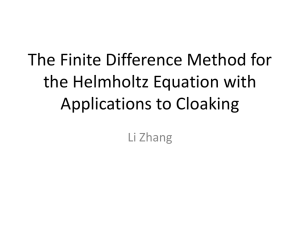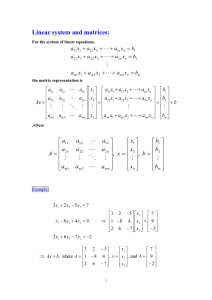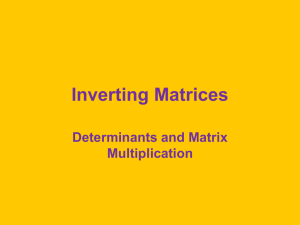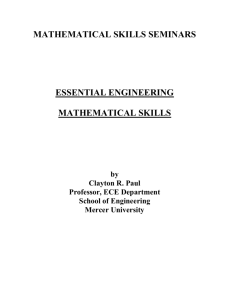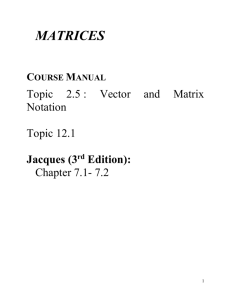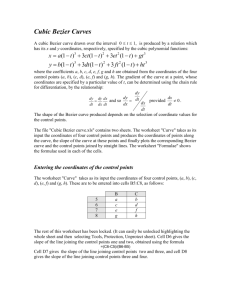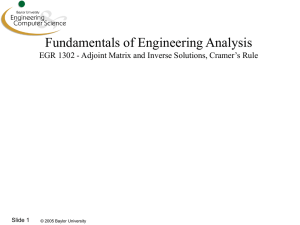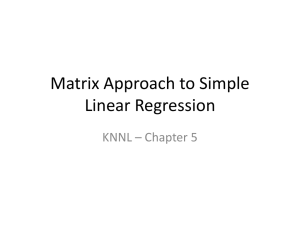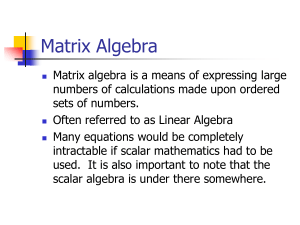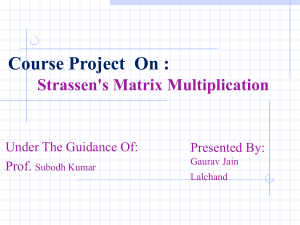Model exercises
advertisement
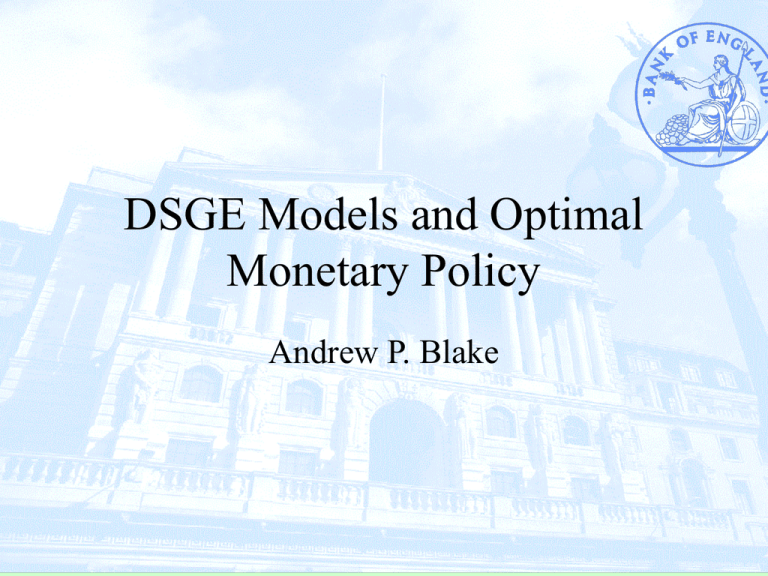
DSGE Models and Optimal Monetary Policy Andrew P. Blake A framework of analysis • Typified by Woodford’s Interest and Prices – Sometimes called DSGE models – Also known as NNS models • Strongly micro-founded models • Prominent role for monetary policy • Optimising agents and policymakers What do we assume? • Model is stochastic, linear, time invariant • Objective function can be approximated very well by a quadratic • That the solutions are certainty equivalent – Not always clear that they are • Agents (when they form them) have rational expectations or fixed coefficient extrapolative expectations Linear stochastic model • We consider a model in state space form: s t 1 As t Bu t C t 1 • u is a vector of control instruments, s a vector of endogenous variables, ε is a shock vector • The model coefficients are in A, B and C Quadratic objective function • Assume the following objective function: V 0 min 1 ut s Qs 2 t t t u t Ru t t0 • Q and R are positive (semi-) definite symmetric matrices of weights • 0 < ρ ≤ 1 is the discount factor • We take the initial time to be 0 How do we solve for the optimal policy? • We have two options: – Dynamic programming – Pontryagin’s minimum principle • Both are equivalent with non-anticipatory behaviour • Very different with rational expectations • We will require both to analyse optimal policy Dynamic programming • Approach due to Bellman (1957) • Formulated the value function: Vt 1 2 s t Ss t min 1 ut 2 s tQs t u t Ru t s t1 Ss t 1 • Recognised that it must have the structure: V t min ut s tQs t u t Ru t ( s t A u t B ) S ( As t Bu t ) Optimal policy rule • First order condition (FOC) for u: Vt ut 0 Ru t B S ( As t Bu t ) 0 • Use to solve for policy rule: 1 u t ( R B SB ) B SAs t Fs t The Riccati equation • Leaves us with an unknown in S • Collect terms from the value function: s t Ss t s tQs t s t F RFs • Drop z: t s t ( A F B ) S ( A BF ) s t S Q F RF ( A F B ) S ( A BF ) Riccati equation (cont.) • If we substitute in for F we can obtain: 2 1 S Q A SA A SB ( R B SB ) B SA • Complicated matrix quadratic in S • Solved ‘backwards’ by iteration, perhaps by: S j Q A S j 1 A A S j 1 B ( R B S j 1 B ) 2 1 B S j 1 A Properties of the solution • • • • ‘Principle of optimality’ The optimal policy depends on the unknown S S must satisfy the Riccati equation Once you solve for S you can define the policy rule and evaluate the welfare loss • S does not depend on s or u only on the model and the objective function • The initial values do not affect the optimal control Lagrange multipliers • Due to Pontryagin (1957) • Formulated a system using constraints as: Hk k s k Qs k u k Ru k k 1 ( As k Bu k s k 1 ) • λ is a vector of Lagrange multipliers: • The constrained objective function is: Vt H k t k FOCs • Differentiate with respect to the three sets of variables: H t u t H t st H t t 0 Ru t B t 1 0 0 Qs t A t 1 t 0 0 As t Bu t s t 1 0 Hamiltonian system • Use the FOCs to yield the Hamiltonian system: I 0 1 B R B s t 1 A A t 1 Q 0 st I t • This system is saddlepath stable • Need to eliminate the co-states to determine the solution • NB: Now in the form of a (singular) rational expectations model (discussed later) Solutions are equivalent • Assume that the solution to the saddlepath problem is t Ss t • Substitute into the FOCs to give: H t u t H t st 0 Ru t B Ss t 1 0 0 Qs t A Ss t 1 Ss t 0 Equivalence (cont.) • We can combine these with the model and eliminate s to give: 2 1 S Q A SA A SB ( R B SB ) B SA • Same solution for S that we had before • Pontryagin and Bellman give the same answer • Norman (1974, IER) showed them to be stochastically equivalent • Kalman (1961) developed certainty equivalence What happens with RE? • Modify the model to: z t 1 A11 A12 z t B1 e ut x t 1 A 21 A 22 x t B 2 • Now we have z as predetermined variables and x as jump variables • Model has a saddlepath structure on its own • Solved using Blanchard-Kahn etc. Bellman’s dedication • At the beginning of Bellman’s book Dynamic Programming he dedicates it thus: To Betty-Jo Whose decision processes defy analysis Control with RE • How do rational expectations affect the optimal policy? – Somewhat unbelievably - no change – Best policy characterised by the same algebra • However, we need to be careful about the jump variables, and Betty-Jo • We now obtain pre-determined values for the costates λ • Why? Pre-determined co-states • Look at the value function V t 12 s t Ss t • Remember the reaction function is: tz S 11 x t S 21 S 12 z t Ss t S 22 x t • So the cost can be written as V t 12 s t t • We can minimise the cost by choosing some co-states and letting x jump Pre-determined co-states (cont.) • At time 0 this is minimised by: V0 1 2 z 0 0z 1 x 0 x z 0 0 2 0z x 0 0 • We can rearrange the reaction function to: tz N 11 x t N 21 • Where N 12 z t x N 22 t 1 1 N 11 S 11 S 12 S 22 S 21 , N 22 S 22 etc Pre-determined co-states (cont.) • Alternatively the value function can be written in terms of the x and the z’s as: zt I x t N 21 0 zt zt x T x N 22 t t • The loss is: V0 1 2 z 0 T ST x 0 z0 x 0 Cost-to-go • • • • At time 0, z0 is predetermined x0 is not, and can be any value In fact is a function of z0 (and implicitly u) We can choose the value of λx at time 0 to minimise cost • We choose it to be 0 • This minimises the cost-to-go in period 0 Time inconsistency • • • • • • This is true at time 0 Time passes, maybe just one period Time 1 ‘becomes time 0’ Same optimality conditions apply We should reset the co-states to 0 The optimal policy is time inconsistent Different to non-RE • We established before that the non-RE solution did not depend on the initial conditions (or any z) • Now it directly does • Can we use the same solution methods? – DP or LM? – Yes, as long as we ‘re-assign’ the co-states • However, we are implicitly using the LM solution as it is ‘open-loop’ – the policy depends directly on the initial conditions Where does this fit in? • Originally established in 1980s – Clearest statement Currie and Levine (1993) – Re-discovered in recent US literature – Ljungqvist and Sargent Recursive Macroeconomic Theory (2000, and new edition) • Compare with Stokey and Lucas How do we deal with time inconsistency? • Why not use the ‘principle of optimality’ • Start at the end and work back • How do we incorporate this into the RE control problem? – Assume expectations about the future are ‘fixed’ in some way – Optimise subject to these expectations A rule for future expectations • Assume that: x e t 1 N t 1 z t 1 • If we substitute this into the model we get: 1 x t ( A 22 N t 1 A12 ) ( N t 1 A11 A12 ) z t 1 ( A 22 N t 1 A12 ) ( N t 1 B1 B 2 ) u t J t zt K tut A rule for future expectations • The ‘pre-determined’ model is: z t 1 A11 z t A12 x t B1u t • Using the reaction function for x we get: z t 1 ( A11 A12 J t ) z t ( B1 B 2 K t ) u t Aˆ t z t Bˆ u t Dynamic programming solution • To calculate the best policy we need to make assumptions about leadership • What is the effect on x of changes in u? • If we assume no leadership it is zero • Otherwise it is K, need to use: Vt u t Vt xt xt u t 0 Vt u t Vt xt Kt Dynamic programming (cont.) • FOC for u for leadership: 1 ˆ ˆ ˆ ˆ u t ( R B t S t 1 B t ) ( B tS t 1 Aˆ t K t ( Q 22 J t Q 21 )) z t Fˆt z t where: Rˆ t R K tQ 22 K t • This policy must be time consistent • Only uses intra-period leadership Dynamic programming (cont.) • This is known in the dynamic game literature as feedback Stackelberg • Also need to solve for S – Substitute in using relations above • Can also assume that x unaffected by u – Feedback Nash equilibrium • Developed by Oudiz and Sachs (1985) Dynamic programming (cont.) • Key assumption that we condition on a rule for expectations • Could condition on a time path (LM) • Time consistent by construction – Principle of optimality • Many other policies have similar properties • Stochastic properties now matter Time consistency • Not the only time consistent solutions • Could use Lagrange multipliers • DP is not only time consistent it is subgame perfect • Much stronger requirement – See Blake (2004) for discussion What’s new with DSGE models? • Woodford and others have derived welfare loss functions that are quadratic and depend only on the variances of inflation and output • These are approximations to the true social utility functions • Can apply LQ control as above to these models • Parameters of the model appear in the loss function and vice versa (e.g. discount factor) DGSE models in WinSolve • Can set up micro-founded models • Can set up micro-founded loss functions • Can explore optimal monetary policy – Time inconsistent – Time consistent – Taylor-type approximations • Let’s do it!
